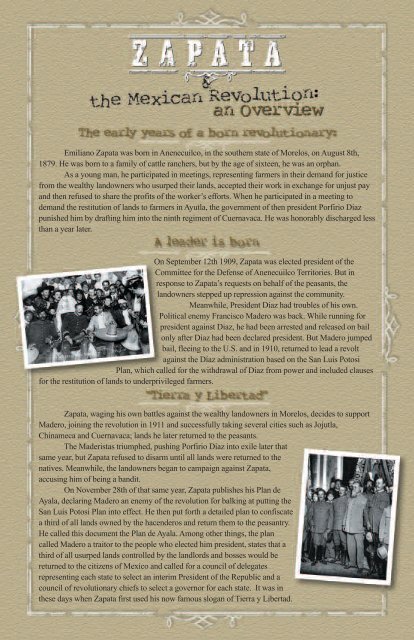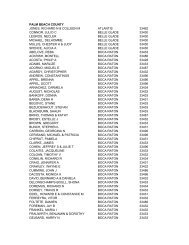Zapata Project 1
Zapata Project 1
Zapata Project 1
You also want an ePaper? Increase the reach of your titles
YUMPU automatically turns print PDFs into web optimized ePapers that Google loves.
Emiliano <strong>Zapata</strong> was born in Anenecuilco, in the southern state of Morelos, on August 8th,<br />
1879. He was born to a family of cattle ranchers, but by the age of sixteen, he was an orphan.<br />
As a young man, he participated in meetings, representing farmers in their demand for justice<br />
from the wealthy landowners who usurped their lands, accepted their work in exchange for unjust pay<br />
and then refused to share the profits of the worker’s efforts. When he participated in a meeting to<br />
demand the restitution of lands to farmers in Ayutla, the government of then president Porfirio Diaz<br />
punished him by drafting him into the ninth regiment of Cuernavaca. He was honorably discharged less<br />
than a year later.<br />
On September 12th 1909, <strong>Zapata</strong> was elected president of the<br />
Committee for the Defense of Anenecuilco Territories. But in<br />
response to <strong>Zapata</strong>’s requests on behalf of the peasants, the<br />
landowners stepped up repression against the community.<br />
Meanwhile, President Diaz had troubles of his own.<br />
Political enemy Francisco Madero was back. While running for<br />
president against Diaz, he had been arrested and released on bail<br />
only after Diaz had been declared president. But Madero jumped<br />
bail, fleeing to the U.S. and in 1910, returned to lead a revolt<br />
against the Díaz administration based on the San Luis Potosi<br />
Plan, which called for the withdrawal of Diaz from power and included clauses<br />
for the restitution of lands to underprivileged farmers.<br />
<strong>Zapata</strong>, waging his own battles against the wealthy landowners in Morelos, decides to support<br />
Madero, joining the revolution in 1911 and successfully taking several cities such as Jojutla,<br />
Chinameca and Cuernavaca; lands he later returned to the peasants.<br />
The Maderistas triumphed, pushing Porfirio Diaz into exile later that<br />
same year, but <strong>Zapata</strong> refused to disarm until all lands were returned to the<br />
natives. Meanwhile, the landowners began to campaign against <strong>Zapata</strong>,<br />
accusing him of being a bandit.<br />
On November 28th of that same year, <strong>Zapata</strong> publishes his Plan de<br />
Ayala, declaring Madero an enemy of the revolution for balking at putting the<br />
San Luis Potosi Plan into effect. He then put forth a detailed plan to confiscate<br />
a third of all lands owned by the hacenderos and return them to the peasantry.<br />
He called this document the Plan de Ayala. Among other things, the plan<br />
called Madero a traitor to the people who elected him president, states that a<br />
third of all usurped lands controlled by the landlords and bosses would be<br />
returned to the citizens of Mexico and called for a council of delegates<br />
representing each state to select an interim President of the Republic and a<br />
council of revolutionary chiefs to select a governor for each state. It was in<br />
these days when <strong>Zapata</strong> first used his now famous slogan of Tierra y Libertad.







